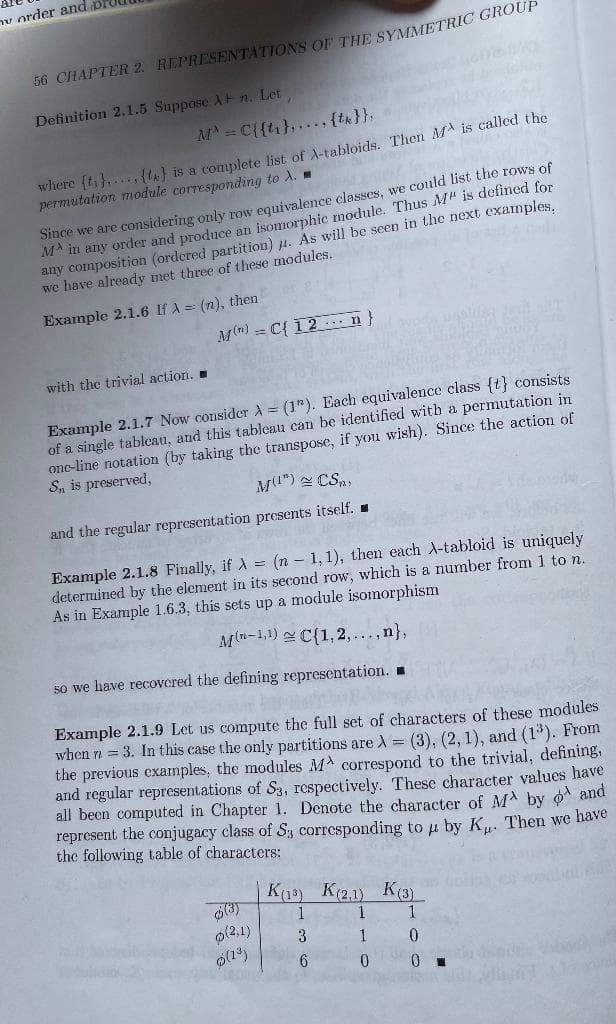Example 2.1.9 Let us compute the full set of characters of these modules when n 3. In this case the only partitions are A = (3), (2, 1), and (1³). From the previous examples, the modules M correspond to the trivial, defining, and regular representations of S3, respectively. These character values have all been computed in Chapter 1. Denote the character of M by and represent the conjugacy class of S, corresponding to by K₁. Then we have the following table of characters: (3) (2,1) Ø(1³) K(13) K(21) K(3) 1 0 0- 1 3 6 1 1 0 Tro
Example 2.1.9 Let us compute the full set of characters of these modules when n 3. In this case the only partitions are A = (3), (2, 1), and (1³). From the previous examples, the modules M correspond to the trivial, defining, and regular representations of S3, respectively. These character values have all been computed in Chapter 1. Denote the character of M by and represent the conjugacy class of S, corresponding to by K₁. Then we have the following table of characters: (3) (2,1) Ø(1³) K(13) K(21) K(3) 1 0 0- 1 3 6 1 1 0 Tro
Classical Dynamics of Particles and Systems
5th Edition
ISBN:9780534408961
Author:Stephen T. Thornton, Jerry B. Marion
Publisher:Stephen T. Thornton, Jerry B. Marion
Chapter7: Hamilton's Principle-lagrangian And Hamiltonian Dynamics
Section: Chapter Questions
Problem 7.36P
Related questions
Question
Could you please explain example 2.1.9 with the table.

Transcribed Image Text:w order and a
56 CHAPTER 2. REPRESENTATIONS OF THE SYMMETRIC GROUP
Definition 2.1.5 Suppose An. Let
M = C{{₁},... {tk}}.
where (t₁)....() is a complete list of A-tabloids. Then MA is called the
permutation module corresponding to A. ■
Since we are considering only row equivalence classes, we could list the rows of
MA in any order and produce an isomorphic module. Thus M" is defined for
any composition (ordered partition) . As will be seen in the next examples.
we have already met three of these modules.
Example 2.1.6 If A = (n), then
with the trivial action. ■
M() = C{12}
Example 2.1.7 Now consider A = (122). Each equivalence class {t} consists
of a single tableau, and this tableau can be identified with a permutation in
one-line notation (by taking the transpose, if you wish). Since the action of
Sn is preserved,
M(1) CS
and the regular representation presents itself. ■
Example 2.1.8 Finally, if λ = (n-1, 1), then each A-tabloid is uniquely
determined by the element in its second row, which is a number from 1 to n.
As in Example 1.6.3, this sets up a module isomorphism
M(-1,1)
C{1,2,...,n},
so we have recovered the defining representation. ■
Example 2.1.9 Let us compute the full set of characters of these modules
when n = 3. In this case the only partitions are A = (3), (2, 1), and (1³). From
the previous examples, the modules M correspond to the trivial, defining,
and regular representations of S3, respectively. These character values have
all been computed in Chapter 1. Denote the character of M by and
represent the conjugacy class of S, corresponding to u by K. Then we have
the following table of characters:
(3)
(2,1)
K(13)
1
3
6
K(2,1)
1
1
0
K(3)
1
0
0
Expert Solution
This question has been solved!
Explore an expertly crafted, step-by-step solution for a thorough understanding of key concepts.
Step by step
Solved in 3 steps

Knowledge Booster
Learn more about
Need a deep-dive on the concept behind this application? Look no further. Learn more about this topic, physics and related others by exploring similar questions and additional content below.Recommended textbooks for you

Classical Dynamics of Particles and Systems
Physics
ISBN:
9780534408961
Author:
Stephen T. Thornton, Jerry B. Marion
Publisher:
Cengage Learning

Classical Dynamics of Particles and Systems
Physics
ISBN:
9780534408961
Author:
Stephen T. Thornton, Jerry B. Marion
Publisher:
Cengage Learning